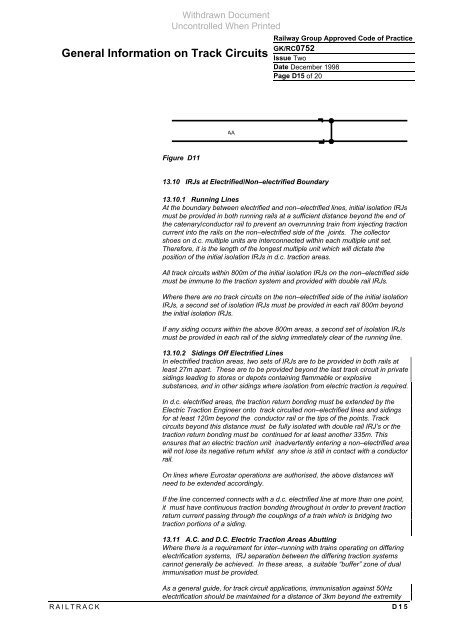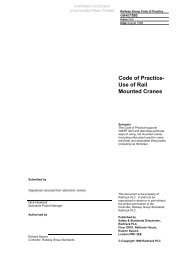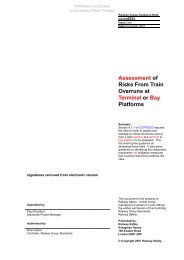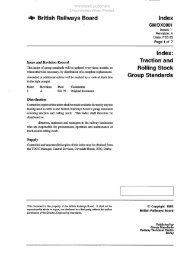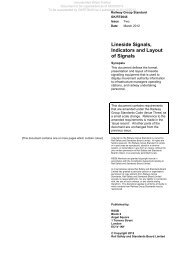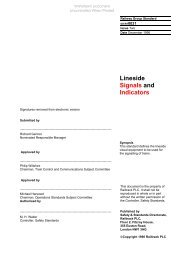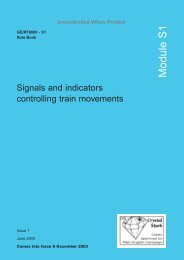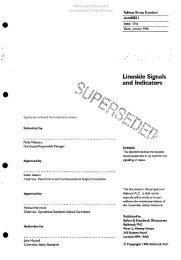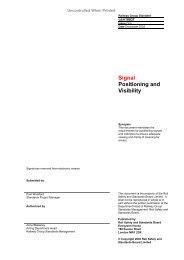General Information on Track Circuits - RGS Online
General Information on Track Circuits - RGS Online
General Information on Track Circuits - RGS Online
You also want an ePaper? Increase the reach of your titles
YUMPU automatically turns print PDFs into web optimized ePapers that Google loves.
Withdrawn Document<br />
Unc<strong>on</strong>trolled When Printed<br />
<str<strong>on</strong>g>General</str<strong>on</strong>g> <str<strong>on</strong>g>Informati<strong>on</strong></str<strong>on</strong>g> <strong>on</strong> <strong>Track</strong> <strong>Circuits</strong><br />
Figure D11<br />
AA<br />
13.10 IRJs at Electrified/N<strong>on</strong>–electrified Boundary<br />
Railway Group Approved Code of Practice<br />
GK/RC0752<br />
Issue Two<br />
Date December 1998<br />
Page D15 of 20<br />
13.10.1 Running Lines<br />
At the boundary between electrified and n<strong>on</strong>–electrified lines, initial isolati<strong>on</strong> IRJs<br />
must be provided in both running rails at a sufficient distance bey<strong>on</strong>d the end of<br />
the catenary/c<strong>on</strong>ductor rail to prevent an overrunning train from injecting tracti<strong>on</strong><br />
current into the rails <strong>on</strong> the n<strong>on</strong>–electrified side of the joints. The collector<br />
shoes <strong>on</strong> d.c. multiple units are interc<strong>on</strong>nected within each multiple unit set.<br />
Therefore, it is the length of the l<strong>on</strong>gest multiple unit which will dictate the<br />
positi<strong>on</strong> of the initial isolati<strong>on</strong> IRJs in d.c. tracti<strong>on</strong> areas.<br />
All track circuits within 800m of the initial isolati<strong>on</strong> IRJs <strong>on</strong> the n<strong>on</strong>–electrified side<br />
must be immune to the tracti<strong>on</strong> system and provided with double rail IRJs.<br />
Where there are no track circuits <strong>on</strong> the n<strong>on</strong>–electrified side of the initial isolati<strong>on</strong><br />
IRJs, a sec<strong>on</strong>d set of isolati<strong>on</strong> IRJs must be provided in each rail 800m bey<strong>on</strong>d<br />
the initial isolati<strong>on</strong> IRJs.<br />
If any siding occurs within the above 800m areas, a sec<strong>on</strong>d set of isolati<strong>on</strong> IRJs<br />
must be provided in each rail of the siding immediately clear of the running line.<br />
13.10.2 Sidings Off Electrified Lines<br />
In electrified tracti<strong>on</strong> areas, two sets of IRJs are to be provided in both rails at<br />
least 27m apart. These are to be provided bey<strong>on</strong>d the last track circuit in private<br />
sidings leading to stores or depots c<strong>on</strong>taining flammable or explosive<br />
substances, and in other sidings where isolati<strong>on</strong> from electric tracti<strong>on</strong> is required.<br />
In d.c. electrified areas, the tracti<strong>on</strong> return b<strong>on</strong>ding must be extended by the<br />
Electric Tracti<strong>on</strong> Engineer <strong>on</strong>to track circuited n<strong>on</strong>–electrified lines and sidings<br />
for at least 120m bey<strong>on</strong>d the c<strong>on</strong>ductor rail or the tips of the points. <strong>Track</strong><br />
circuits bey<strong>on</strong>d this distance must be fully isolated with double rail IRJ’s or the<br />
tracti<strong>on</strong> return b<strong>on</strong>ding must be c<strong>on</strong>tinued for at least another 335m. This<br />
ensures that an electric tracti<strong>on</strong> unit inadvertently entering a n<strong>on</strong>–electrified area<br />
will not lose its negative return whilst any shoe is still in c<strong>on</strong>tact with a c<strong>on</strong>ductor<br />
rail.<br />
On lines where Eurostar operati<strong>on</strong>s are authorised, the above distances will<br />
need to be extended accordingly.<br />
If the line c<strong>on</strong>cerned c<strong>on</strong>nects with a d.c. electrified line at more than <strong>on</strong>e point,<br />
it must have c<strong>on</strong>tinuous tracti<strong>on</strong> b<strong>on</strong>ding throughout in order to prevent tracti<strong>on</strong><br />
return current passing through the couplings of a train which is bridging two<br />
tracti<strong>on</strong> porti<strong>on</strong>s of a siding.<br />
13.11 A.C. and D.C. Electric Tracti<strong>on</strong> Areas Abutting<br />
Where there is a requirement for inter–running with trains operating <strong>on</strong> differing<br />
electrificati<strong>on</strong> systems, IRJ separati<strong>on</strong> between the differing tracti<strong>on</strong> systems<br />
cannot generally be achieved. In these areas, a suitable “buffer” z<strong>on</strong>e of dual<br />
immunisati<strong>on</strong> must be provided.<br />
As a general guide, for track circuit applicati<strong>on</strong>s, immunisati<strong>on</strong> against 50Hz<br />
electrificati<strong>on</strong> should be maintained for a distance of 3km bey<strong>on</strong>d the extremity<br />
RAILTRACK D15


